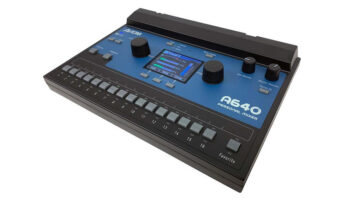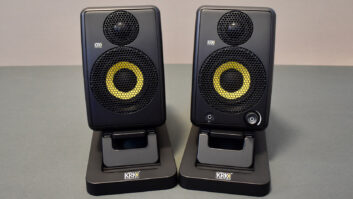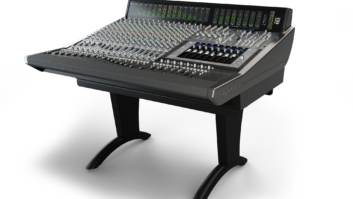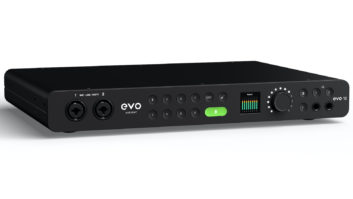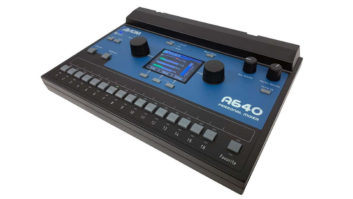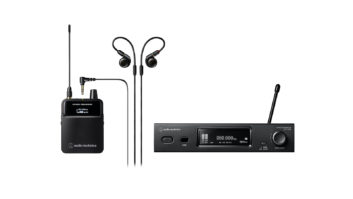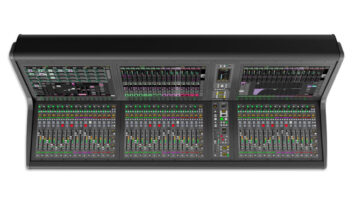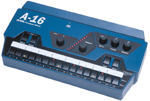
We spend years tweaking and experimenting, constantly trying
different pieces of gear and techniques to achieve the perfect mix.
However, while creating monitor mixes (whether onstage or in session),
we have to please the performers themselves — some very
particular customers. After all, artists perform better when they like
their monitor mixes.
We always seem to experience a shortage of pre-fade console sends,
limiting the number of available cue mixes. So do you please the
drummer, the bassist, the singer or the lead guitar player, not to
mention three backup vocalists, two keyboardists, a horn section and a
conga player? Even in pro live sound with a dedicated monitor engineer,
do the backup singers really get as much attention to their mixes as
the diva — or divo? And time is always tight, whether during
soundchecks or setting up for a tracking date.
One possible solution to this situation is the Aviom A-16 Personal
Monitor Mixing System, which gives performers individual control over
16 input channels to create their own stereo monitor mixes. Custom
mixes can be saved for later recall, and the mix output can be routed
to headphones, spot monitors, floor wedges or in-ear monitors.
One thing that sets the Aviom A-16 apart from earlier monitor mix
systems is its use of A-Net, a proprietary LAN technology optimized for
real-time multichannel digital audio transmission. A-Net allows the
transmission of 16 channels of 24-bit digital audio over a single Cat-5
cable, with up to 500 feet between components. The protocol is based on
— but is not — Ethernet, although the A-16 uses
RJ-45 network connectors and standard Cat-5 interface cabling.
The system comprises a single-rackspace A-16T Transmitter ($749.95),
which takes up to 16 analog line-level inputs, converts them to 24-bit
digital form and packetizes those channels into the A-Net format, which
is sent out over Cat-5 cable to any number of A-16 Personal Mixer units
($439.95/each). The A-16T’s front-panel controls include switches for
input level matching, with four settings (-10/0/+4/+22 dB); switches
for linking channels to operate as stereo pairs; individual signal
presence and clip lights for each of the 16 channels; and an RJ-45
A-Net output jack. The rear panel has 16 ¼-inch TRS inputs
(accepting balanced or unbalanced sources) and 16 identical channel
thru jacks, which provide a copy of the signal that is plugged into the
input jack above it. These are ideal for applications where users don’t
have 16 available sends and want to use channel or group insert jacks
to interface with the Transmitter.
Once at the A-16 mixer, the channels are converted back to analog
and users have fingertip-control over volume, panning, mutes, grouping
treble and bass. There are 16 memory locations to store user presets.
The mixer’s connections include A-Net input and output (the latter for
daisy-chaining another A-16 mixer into the system), master output (with
volume pot) for headphones or driving powered monitors, and power input
for the (included) external DC power adapter.
System setup is straightforward: I patched the A-16T’s inputs into
my console, flipped the unit’s gain switches until the clip lights went
off, ran the A-Net cable from the Transmitter to the first A-16 mixer
and I was set — sort of. You see, I have in-wall snakes for mic
lines, headphone feeds and even low-capacitance MIDI cabling from my
control room into the studio. However, I don’t have any Cat-5 runs, so
we had to route the cable out of the control room’s door to reach the
studio. In my room, the supplied 30-foot cable wasn’t long enough, so
we substituted a 50-foot network cable (available at most computer
stores or from Aviom) that worked fine. Running a cable out the door,
down the hall and across the floor wasn’t pretty, but it worked, and
because the cable is very small in diameter, it can be concealed/routed
much more easily than a 16-line analog snake! Also, Cat-5 cable is
relatively easy to install and can be run through walls and terminated
in an RJ-45 jackplate for permanent installs.
Once hooked up, everything went smoothly, with the main snag being
that the mixers are lightweight and, with three or four cables
attached, tend to slide off surfaces. This is solved by an optional
$24.95 mic stand mount.
Creating A-16 monitor mixes is no sweat: Just press the Select
button for any of the 16 channels, turn the gain and pan knobs to your
liking, and repeat the process on the other channels. The whole
procedure takes about a minute or two. Multiple faders can then be
grouped for soloing or muting and saved for immediate recall, which
takes no more than five minutes to master. Simplicity is the key here.
The treble and bass controls are ±12dB shelving filters at 160 Hz
and 9 kHz and are quite musical. The output control was loud enough to
drive drummer headphones — no problem here — and system
latency was virtually imperceptible.
The A-16 system works well and does what it promises. For anyone
seeking more advanced control, the rackmount $799.95 A-16R Personal
Mixer (shipping this month) can substitute for any A-16 mixer in the
chain, adding balanced outs, stereo insert points and a stereo aux mix
input (for click tracks, other source feeds, etc.). But either way, the
A-16 system puts cutting-edge technology into an affordable and
flexible solution for musicians onstage or in the studio.
Aviom Inc., 610/738-9005, www.aviom.com.
